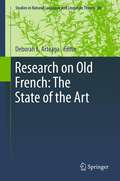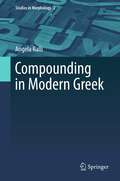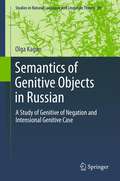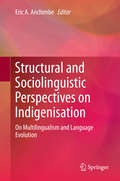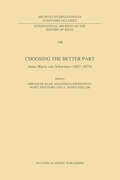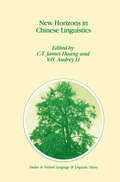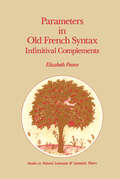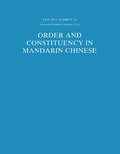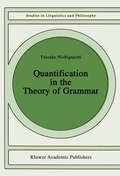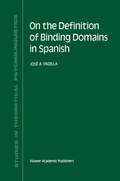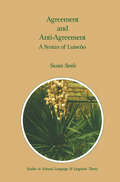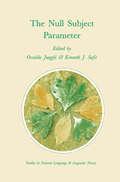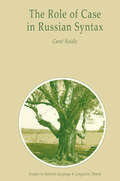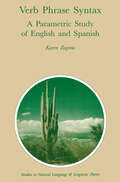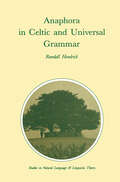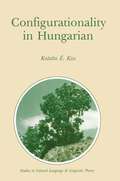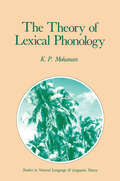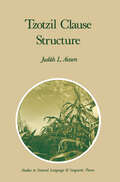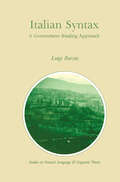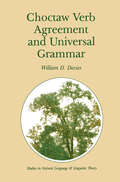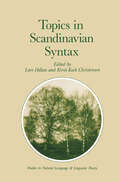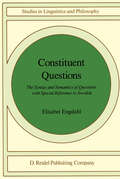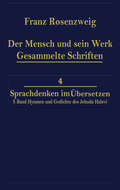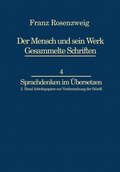- Table View
- List View
Research on Old French: The State of the Art (Studies in Natural Language and Linguistic Theory #88)
by Deborah L. ArteagaThe present volume presents scholarly study into Old French as it is practiced today, in all of its forms, within a variety of theoretical frameworks, from Optimality Theory to Minimalism to Discourse Analysis. Many of the chapters are corpus-based, reflecting a new trend in the field, as more electronic corpora become available. The chapters contribute to our understanding of both the synchronic state and diachronic evolution, not only of Old French, but of language in general. Its breadth is extensive in that contributors pursue research on a wide variety of topics in Old French focusing on the various subsystems of language. All examples are carefully glossed and the relevant characteristics of Old French are clearly explained, which makes it uniquely accessible to non-specialists and linguists at all levels of training.
Compounding in Modern Greek (Studies in Morphology #2)
by Angela RalliOne of the core challenges in linguistics is elucidating compounds—their formation as well as the reasons their structure varies between languages. This book on Modern Greek rises to the challenge with a meticulous treatment of its diverse, intricate compounds, a study as grounded in theory as it is rich in data. Enhancing our knowledge of compounding and word-formation in general, its exceptional scope is a worthy model for linguists, particularly morphologists, and offers insights for students of syntax, phonology, dialectology and typology, among others. The author examines first-tier themes such as the order and relations of constituents, headedness, exocentricity, and theta-role saturation. She shows how Modern Greek compounding relates to derivation and inflection, and charts the boundaries between compounds and phrases. Exploring dialectically variant compounds, and identifying historical changes, the analysis extends to similarly formed compounds in wholly unrelated languages.
Semantics of Genitive Objects in Russian: A Study of Genitive of Negation and Intensional Genitive Case (Studies in Natural Language and Linguistic Theory #89)
by Olga KaganThe genitive/accusative opposition in Slavic languages is a decades-old linguistic conundrum. Shedding new light on this perplexing object-case alternation in Russian, this volume analyzes two variants of genitive objects that alternate with accusative complements—the genitive of negation and the intensional genitive. The author contends that these variants are manifestations of the same phenomenon, and thus require an integrated analysis. Further, that the choice of case is sensitive to factors that fuse semantics and pragmatics, and that the genitive case is assigned to objects denoting properties at the same time as they lack commitment to existence. Kagan’s subtle analysis accounts for the complex relations between case-marking and other properties, such as definiteness, specificity, number and aspect. It also reveals a correlation between the genitive case and the subjunctive mood, and relates her overarching subject matter to other instances of differential object-marking.
Structural and Sociolinguistic Perspectives on Indigenisation: On Multilingualism and Language Evolution
by Eric A. AnchimbeDescriptions of new varieties of European languages in postcolonial contexts have focused exceedingly on system-based indigenisation and variation. This volume–while further illustrating processes and instantiations of indigenisation at this level–incorporates investigations of sociolinguistic and pragmatic phenomena in daily social interaction–e.g. politeness, respect, compliment response, naming and address forms, and gender–through innovative analytic frameworks that view indigenisation from emic perspectives. Focusing on postcolonial Cameroon and using natural and questionnaire data, the book assesses the salience of linguistic and sociocultural hybridisation triggered by colonialism and, recently, globalisation in interaction in and across languages and cultures. The authors illustrate how the multilingual nature of the society and individuals’ multilingual repertoires shape patterns in the indigenisation and evolution of the ex-colonial languages, English and French, and Pidgin English.
Choosing the Better Part: Anna Maria van Schurman (1607–1678) (International Archives of the History of Ideas Archives internationales d'histoire des idées #146)
by A. AgnesSneller MaritMonteiro MachteldLöwensteyn MirjamBaarAnna Maria van Schurman was in more than one aspect an unconventional woman in her own lifetime. As a gifted scholar in many foreign and ancient languages, as well as in philosophy and theology, she corresponded with other learned men and women all over Europe. She achieved international renown for her own defence of scholarly activity of women. Life and work of this Dutch femme savante of the 17th Century has thus far been studied by theologians, philosophers, literary scholars, historians, pedagogues and art historians, each concentrating on specific aspects of Van Schurman's biography or work. A rather fragmented image of this scholar was the result. This interdependent collection of essays describes the life and work of Anna Maria van Schurman from an interdisciplinary - or rather multidisciplinary - approach and will outline a more integrated yet at the same time subtly differentiated picture. Nine contributions - from the disciplines of philosophy, theology, Dutch language and literature, intellectual and art history, and women's studies - partly based on new source material, shed light on Van Schurman's ideas on erudition and femininity, ethics and philosophy, as well as on her religious beliefs, within the context of the early modern intellectual community to which she belonged. Audience: This collection of essays will therefore command the interest not only of historians, but also of scholars and students in theology, philosophy, art history, and women's studies.
New Horizons in Chinese Linguistics (Studies in Natural Language and Linguistic Theory #36)
by Liliane HaegemanThe past decade and a half has witnessed a great deal of renewed interest in the study of Chinese linguistics, not only in the traditional areas of philological studies and in theoretically oriented areas of syn chronic grammar and language change but also in the cultivation of new frontiers in related areas of the cognitive sciences. There is a significant increase in the number of students studying one area or another of the linguistic structure of Chinese in various linguistic programs in the United States, Europe, Australia and in China, Hong Kong, Singapore, Taiwan, and other parts of Asia. Several new academic departments devoted to the study of linguistics have been established in Taiwan and Hong Kong in the past few years. The increasing research and study activities have also resulted in a number of national and international conferences, including the North American Conference on Chinese Linguistics (NACCL), which has been held annually in the United States; the International Symposium on Chinese Languages and Linguistics (IsCLL), which has had its fourth meeting since it was launched by Academia Sinica in Taiwan in 1990; the International Association of Chinese Linguistics (lACL), created in Singapore in 1992 and now incorporated in Irvine, California, which has held its annual meetings at major institutions in Asia, Europe, and the US.
Parameters in Old French Syntax: Infinitival Complements (Studies in Natural Language and Linguistic Theory #18)
by E.H. Pearce1.1. AIMS AND ASSUMPTIONS This book presents an analysis of infinitival complement constructions in Old French (OF) from the perspective of the Government-Binding (GB) framework. It aims, therefore, to establish within the terms of the GB framework just how the OF constructions are to be characterized and in just what sense they can or cannot be compared with the corresponding constructions in other Romance languages. The GB framework is an articulated theory about the structure of language which is based on the view that the aim of research into language is to construct a description of language which accurately reflects its essential nature. Whilst we know that individual languages may appear to be superficially very different, we also know that all languages are capable of expressing complex concepts and that all children acquire mastery of the language or languages to which they are exposed. The task, therefore, is to determine both the properties which languages have in common and the bounds within which they may differ. In the pursuit of these aims, the study of various languages of the Romance family has provided a rich source of material for the develop ment of the descriptive apparatus. Evidence of the contribution supplied by such work is apparent in references to Romance material in Chomsky (1981, 1982), in volumes such as Jaeggli (1982), Rizzi (1982a), Kayne (1984b), Burzio (1986), and in numerous papers devoted to particular constructions in a variety of Romance languages.
Order and Constituency in Mandarin Chinese (Studies in Natural Language and Linguistic Theory #19)
by Audrey Li Yen HuiRecent developments in generative grammar have been very stimulating. The current theory defines a small set of principles that apply to all human languages. Efforts have been made to demonstrate the adequacy of this theory for a wide range of languages. We thus see an interesting interface of theory and empirical data: the study of natural languages contributes to defining the properties of Universal Grammar and the predictions of the theory help in uncovering generalizations regarding natural languages. This book aims to add to this exciting development by showing how the analysis of Mandarin Chinese constituent structures helps to define Case Theory and how interesting generalizations concerning Chinese grammar are uncovered through verification of the theoretical predictions. Starting from the inadequacy of work by Koopman, Li, and Travis on the effect of Case directionality on word order, the book shows that a detailed study of Chinese constituent structures allows us to reduce the phrase structure component to a minimal statement concerning the position of the head in a given phrase. It argues that in a given language the constituent structures can be adequately captured by the interaction of Case Theory, Theta Theory, Government Theory, and X Theory. Long standing controversies concerning Chinese basic word order are resolved by showing that underlying word order generalizations can differ from surface word order generalizations.
Quantification in the Theory of Grammar (Studies in Linguistics and Philosophy #37)
by Taisuke NishigauchiIn the past few decades, the development of theoretical linguistics has proved to be successful in shedding light on the intricate nature of language and knowledge of grammar, which contributes to a deeper understanding of the human mind. This book discusses various issues in syntax and logical structure of natural language from theoretical perspectives. The primary data on which theoretical claims are made is drawn from Japanese and Japanese-type languages, but it also contains discussion of related phenomena in English which have never been discussed from the same viewpoint in the current literature. Although the book is written in the format of a version of the Extended Standard Theory tradition, informally referred to as the Principles and Parameters Approach or 'Government and Binding (OB) Theory', it should be of interest to a much wider audience. The reader interested in other theoretical frameworks will find the discussion in this book easily translatable in the framework of his or her choice - in fact, I would like to claim that the problems posed by this book are inevitable in any theory of syntax and semantics of natural language.
On the Definition of Binding Domains in Spanish: Evidence from Child Language (Studies in Theoretical Psycholinguistics #11)
by J.A. PadillaLinguistic theory has recently experienced a shift in its conceptual approach from the formulation of descriptively adequate accounts of languages to the definition of principles and parameters claimed to reflect the initial structure of the language faculty, often termed Universal Grammar (UG). Linguistic experience is said to have the effect of guiding the child/linguist in fixing the unspecified parameters of U G to determine the grammar of his/her language. The study of anaphora has been of central concern as it addresses directly the innateness vs. experience issue. On the one hand, it is a part of all natural languages that is largely under determined by the data, and must therefore be included in the characterization of the initial state of the language faculty. On the other hand, although the principles that govern anaphora do not exhibit extreme variations across languages, a child/linguist must solve language specific issues for his/her language based on linguistic experience. This book examines a set of linguistic structures from both a theoretical and an experimental perspective. The purpose is to xv PREFACE xvi determine the roles of innateness and of experience in the devel opment of a child's theory of anaphora for his/her language.
Agreement and Anti-Agreement: A Syntax of Luiseño (Studies in Natural Language and Linguistic Theory #17)
by Susan SteeleThe Null Subject Parameter (Studies in Natural Language and Linguistic Theory #15)
by Osvaldo A. Jaeggli and Kenneth J. SafirThe Role of Case in Russian Syntax (Studies in Natural Language and Linguistic Theory #10)
by C. NeidleVerb Phrase Syntax: A Parametric Study of English and Spanish (Studies in Natural Language and Linguistic Theory #13)
by Karen ZagonaThis study is concerned with the structure of verb phrases in English and Spanish, and with syntactic processes involving VP and Vo. A primary focus of attention is auxiliary verbs. It is argued that the structure dominating these verbs is essentially the same in English and Spanish, as is the structure dominating auxiliaries and 'main' verbs in each language. It must be concluded that the occurrence of distinct syntactic processes affecting auxiliaries and other VP constituents in the two languages does not follow from parametrization of phrase structure. It is argued that similarities between the two languages with respect to the composition of so-called "V*" constructions derive from the fact that VP is licensed under both clauses of the Principle of Full Interpretation, i. e. , predication and sub categorization. Distinct syntactic processes in English and Spanish are argued to follow from the fact that there are inflectional features related to each of these licensing conditions (including specification for [ ± PAST) and nominal person/number features) which affect government relations in distinct ways, resulting in parametrization of S-structure representa tions. xi ACKNOWLEDGMENTS I wish to express my appreCiatIOn to the Department of Romance Languages at the University of Washington for support for preparation of the final manuscript, and to the Department of Spanish, Italian and Portuguese at the University of Virginia for a leave during which much of this research was accomplished.
Anaphora in Celtic and Universal Grammar (Studies in Natural Language and Linguistic Theory #14)
by R. HendrickThis book is based in large part on fieldwork that I conducted in Brittany and Wales in 1983 and 1985. I am thankful for a Fulbright Award for Research in Western Europe and a Faculty Development Award from the University of North Carolina that funded that fieldwork. lowe a less tangible, but no less real, debt to Steve Anderson, G. M. Awbery, Steve Harlow and Jim McCloskey whose work initially sparked my interest, and led me to undertake this project. I want to thank Joe Emonds and Alec Marantz who read portions of Chapter 3 and 5. I am particularly grateful though to Kathleen Flanagan, Frank Heny and two anonymous referees who read a dyslexic and schizophrenic manuscript, providing me with criticisms that improved this final version considerably. The Welsh nationalist community in Aberstwyth and its Breton coun terpart in Quimper helped make the time I spent in Wales and Brittany productive. I am indebted to Thomas Davies, Partick Favreau, Lukian Kergoat, Sue Rhys, John Williams and Beatrice among others for sharing their knowledge of their languages with me. Catrin Davies and Martial Menard were especially patient and helpful. Without their assistance this work would have been infinitely poorer. I am hopeful that this book will help stimulate more interest in the Celtic languages and culture, and assist, even in a small way, those in Wales and Brittany who struggle to keep their language and culture strong.
Configurationality in Hungarian (Studies in Natural Language and Linguistic Theory #3)
by Katalin E. KissThe purpose of this book is to argue for the claim that Hungarian sentence structure consists of a non-configurational propositional component, preceded by configurationally determined operator positions. In the course of this, various descriptive issues of Hungarian syntax will be analyzed, and various theoretical questions concerning the existence and nature of non configurational languages will be addressed. The descriptive problems to be examined in Chapters 2 and 3 center around the word order of Hungarian sentences. Chapter 2 identifies an invariant structure in the apparently freely permutable Hungarian sentence, pointing out systematic correspondences between the structural position, interpre tation, and stressing and intonation of the different constituents. Chapter 3 analyzes the word order phenomenon traditionally called 'sentence inter- I twining' of complex sentences, and shows that the term, in fact, covers two different constructions (a structure resulting from operator movement, and a base generated pattern) with differences in constituent order, operator scope and V-object agreement. Chapter 4 deals interpretation, case assignment, with the coreference possibilities of reflexives, reciprocals, personal pro nouns, and lexical NPs. Finally, Chapter 5 assigns structures to the two major sentence types containing an infinitive. It analyzes infinitives with an AGR marker and a lexical subject, focusing on the problem of case assignment to the subject, as well as subject control constructions, accounting for their often paradoxical, simultaneously mono- and biclausal behaviour in respect to word order, operator scope, and V-object agreement.
The Theory of Lexical Phonology (Studies in Natural Language and Linguistic Theory #6)
by K.P. MohananTzotzil Clause Structure (Studies in Natural Language and Linguistic Theory #7)
by J. Aissenxv NOTES ON THE ORTHOGRAPHY AND CITATIONS xxi LIST OF ABBREVIA TIONS XXIIl CHAPTER 1: GRAMMATICAL NOTES 1 1. Introduction 1 2. Basics 1 3. Major Lexical Classes 2 3. 1. V 3 3. 2. N 3 3. 3. A 5 3. 3. 1. Quantifiers 6 3. 3. 2. Existentials and Locatives 6 4. Minor Lexical Classes 7 4. 1. Clitics 7 4. 1. 1. Clause-proclitic 7 4. 1. 2. S-enclitic 8 4. 1. 3. V-enclitic 8 4. 1. 4. Clause-second 9 4. 2. Directionals 9 4. 3. Particles 11 5. Flagging 11 6. Word Order 12 7. Construction Survey 12 7. 1. Negation 12 13 7. 2. Questions 7. 3. Complement Clauses 14 16 7. 4. Motion cum Purpose 17 7. 5. Topics 7. 6. Prepredicate Position 18 19 Notes CHAPTER 2: THEORETICAL SKETCH 20 20 1. Arcs vii Vlll T ABLE OF CONTENTS 1. 1. Sets of Grammatical Relations 22 1. 2. Stratum 24 Ergative and Absolutive 1. 3. 25 1. 4. 25 Formal Connections between Arcs 2. Sponsor and Erase 26 2. 1. Successors 26 2. 2. Replacers 28 2. 3. Self-Sponsor and Self-Erase 30 3. Ancestral Relations 31 4. Pair Networks 31 Resolution of Overlapping Arcs 32 5. 6. Coordinate Determination 33 7. Rules and Laws 35 8. Word Order 36 9. APG Versions of RG Laws 36 9. 1. Stratal Uniqueness Law 36 9. 2. Chomeur Law and Motivated Chomage Law 36 Relational Succession Law and Host Limitation Law 9. 3.
Italian Syntax: A Government-Binding Approach (Studies in Natural Language and Linguistic Theory #1)
by L. BurzioIn the course of our everyday lives, we generally take our knowledge of language for granted. Occasionally, we may become aware of its great practical importance, but we rarely pay any attention to the formal properties that language has. Yet these properties are remarkably complex. So complex that the question immediately arises as to how we could know so much. The facts that will be considered in this book should serve well to illustrate this point. We will see for example that verbs like arrivare 'arrive' and others like telefonare 'telephone', which are superficially similar, actually differ in a large number of respects, some fairly well known, others not. Why should there be such differencces. we may ask. And why should it be that if a verb behaves like arrivare and unlike tetefonare in one respect. it will do so in all others consistently, and how could everyone know it? To take another case, Italian has two series of pronouns: stressed and unstressed. Thus, for example, alongside of reflexive se stesso 'himself which is the stressed form. one finds si which is unstressed but otherwise synonymous. Yet we will see that the differences between the two could not simply be stress versus lack of stress, as their behavior is radically different under a variety of syntactic conditions.
Choctaw Verb Agreement and Universal Grammar (Studies in Natural Language and Linguistic Theory #2)
by William D. DaviesTone in Lexical Phonology (Studies in Natural Language and Linguistic Theory #4)
by Douglas PulleyblankThis book is a revised version of my Ph.D. dissertation that was submitted to the Massachusetts Institute of Technology in 1983. Although much of the analysis and argumentation of the dissertation has survived rewriting, the organization has been considerably changed. To Paul Kiparsky and Morris Halle, lowe a major debt. Not only has it been a great privilege to work on phonology with both of them, but it is hard to imagine what this piece of research would have looked like without them. (They, of course, may well imagine a number of appropriate ways in which the work could be different had I not been involved .... ) In addition, special thanks are due to Ken Hale, the third member of my thesis committee. Our discussions of a variety of topics (including tone) helped me to keep a broader outlook on language than might have otherwise been the result of concentrating on a thesis topic.
Topics in Scandinavian Syntax (Studies in Natural Language and Linguistic Theory #5)
by L. Hellan K. K. ChristensenThe present collection of papers grew out of a Workshop on Scandinavian Syntax and Theory of Grammar, held in Trondheim in 1982. Five of the contributions - those by Maling, Herslund, Cooper, Platzack and Thniinsson - are developments of papers read at this workshop, and all of the contributions reflect (and have partly inspired) the strong momentum which this area of research has gained over the last few years. It is our hope that the collection will be useful for those who want to familiarize themselves with this research, as well as for those actively engaged in it. We are grateful to the authors for their collaboration in getting the volume together, and to Frank Heny and the Reidel staff (Martin Scrivener, editor, in particular) for their help, encouragement and patience through the various phases of the production of this book. Very many thanks also to our anonymous referees, and to Elisabet Engdahl for help and advice. KIRST! KOCH CHRISTENSEN LARS HELLAN vii LARS HELLAN AND KIRSTI KOCH CHRISTENSEN INTRODUCTION O. INTRODUCTION A natural theoretical perspective for a language-family-oriented anthology like the present one is that of COMPARATIVE RESEARCH. This is not to say that the papers of this volume are all focused on comparative issues (in fact, most of them are not), but rather that the language family from which most of the data are drawn lends itself naturally to comparative studies.
